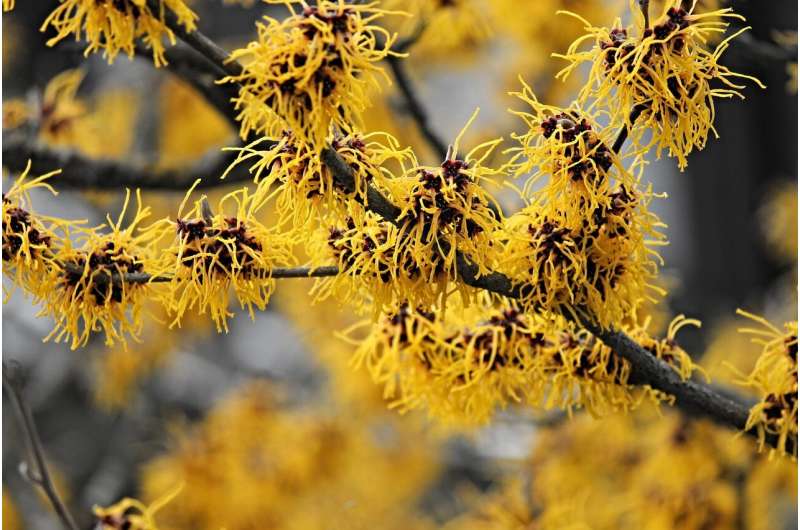This article has been reviewed according to Science X's editorial process and policies. Editors have highlighted the following attributes while ensuring the content's credibility:
fact-checked
peer-reviewed publication
trusted source
proofread
Blink and you'll miss these plants shooting their seeds

If you happened upon a witch hazel plant in the forest, you might describe it as a sweet-smelling shrub with crinkly ribbon-like petals. But to Duke University graduate student Justin Jorge, it's a howitzer.
That's because of the impressive firepower of its fruits.
When witch hazels are ready to disperse their seeds, their woody seed capsules split open. Pressure builds up, and eventually the seeds shoot out like bullets fired from a rifle, hitting 30 feet per second in about half a millisecond.
"If you blink you'll miss it," said Jorge, who worked on this project as part of his Ph.D. thesis in biomechanics with senior author Sheila Patek.
The seed-shooting happens way too fast to see with a regular camera, so Patek's team used a high-speed video camera capable of recording at 100,000 frames per second.
The researchers collected fruits from three members of the witch hazel family found in Duke Gardens or Duke Forest. Some of the smallest seeds weighed in at 15 milligrams—lighter than a grain of rice—while others were 10 times more massive. And yet the witch hazels were able to fling heavyweight seeds just as fast as lighter ones.
"We found that the speed launch speeds were all roughly the same," Jorge said. "Given the order of magnitude difference in seed masses, I was not expecting that at all."
For their study, published Aug. 23 in the Journal of the Royal Society Interface, the researchers looked into how they do it.
It turns out the plants' secret lies in their spring-loaded launch. The three species in the study use the same mechanism to shoot their seeds.
Before the seeds pop out, the fruit capsule around them dries out and deforms, like a piece of wood when if warps. It's the walls of the woody fruit capsule squeezing in that eventually send the seed flying.
"It's similar to how you can shoot out a watermelon seed by squeezing it between your fingers," Jorge said.
To launch a cannonball the same speed as a bullet, you'd need to put more force behind it. Witch hazels do the same thing, but with springs.
For each species, the researchers estimated the elastic potential energy stored in the spring-like seed capsule by measuring how much force it took to wedge its seed back into place.
They found that witch hazel species with heavier seeds also have larger capsules that are able to store more elastic energy.
As a next step, Jorge is looking at the forces acting on witch hazel seeds as they fly through the air and how far they can travel.
The researchers say that some of the lessons learned from nature could lead to better designs for robots.
"People ask me all the time, 'why are you looking at seed-shooting plants?'" Jorge said. "It's the weirdness of their springs," he added.
"When we think of springy things, we typically think of rubber bands, coils, or archery bows," Jorge said. "But in biology, we have all these weird, complex shapes. Perhaps there are some benefits to these shapes that can be used to improve the design of synthetic springs, such as those used in small jumping robots, but first we need to understand how these biological springs work."
More information: Justin F. Jorge et al, Elastic pinch biomechanisms can yield consistent launch speeds regardless of projectile mass, Journal of The Royal Society Interface (2023). DOI: 10.1098/rsif.2023.0234
Journal information: Journal of the Royal Society Interface
Provided by Duke University


















